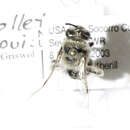Distribution
provided by Catalog of Hymenoptera in America North of Mexico
Tex. west to south. Calif. (Ariz., Calif., Nev., N. Mex., and Tex.); Mexico (Baja California).
- bibliographic citation
- Catalog of Hymenoptera in America North of Mexico. 1979. Prepared cooperatively by specialists on the various groups of Hymenoptera under the direction of Karl V. Krombein and Paul D. Hurd, Jr., Smithsonian Institution, and David R. Smith and B. D. Burks, Systematic Entomology Laboratory, Insect Identification and Beneficial Insect Introduction Institute. Science and Education Administration, United States Department of Agriculture.
Distribution
provided by Catalog of Hymenoptera in America North of Mexico
Tex. west to south. Calif. (Ariz., Calif., Nev., N. Mex., and Tex.); Mexico (Baja California).
- bibliographic citation
- Catalog of Hymenoptera in America North of Mexico. 1979. Prepared cooperatively by specialists on the various groups of Hymenoptera under the direction of Karl V. Krombein and Paul D. Hurd, Jr., Smithsonian Institution, and David R. Smith and B. D. Burks, Systematic Entomology Laboratory, Insect Identification and Beneficial Insect Introduction Institute. Science and Education Administration, United States Department of Agriculture.
Comprehensive Description
provided by Smithsonian Contributions to Zoology
Colletes louisae Cockerell
This species has long been known under its more recent name C. tucsonensis, which has been synonymized by Stephen (1954). It ranges through the Larrea-belt from western Texas and adjacent northern Mexico to southern California and Baja California Norte. Timberlake (1943) reports that it is principally an autumnal species, at least in southern California where it occurs abundantly on the Mojave and Colorado deserts. However, a smaller vernal brood occurs regularly, visiting various Compositae (e.g., Malacothrix, Geraea, Baileya, Encelia) and desert shrubs (including Agave, Cercidium, Prosopis, and Larrea). Females carrying Larrea pollen have been captured sparingly in Riverside and San Bernardino counties, but this host is probably used to some extent throughout the range of the spring brood.
According to Timberlake (1943), females of the autumnal brood visit Compositae exclusively. He also reports finding males swarming in large numbers at flowers of Ericameria on the Mojave Desert in October. We have taken females at Chrysothamnus in the same general area.
- bibliographic citation
- Hurd, Paul D., Jr. and Linsley, E. Gorton. 1975. "The principal Larrea bees of the southwestern United States (Hymenoptera, Apoidea)." Smithsonian Contributions to Zoology. 1-74. https://doi.org/10.5479/si.00810282.193

